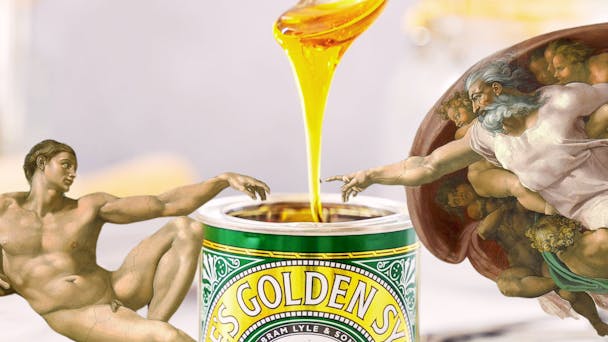Lyle’s rebrand uproar reveals difficulty balancing tradition and modernity
The pantry favorite riled Christians by removing biblical script from its branding. The Team’s Kevin MacKenzie believes this encapsulates a broader issue with brands shunning tradition, adopting golden idols and getting into sticky situations.

As part of The Drum’s Food & Drink Focus, I felt compelled to comment on something that’s been rocking the UK media this week. A rebrand of a golden syrup. It’s not entirely surprising that a logo created in 1883 might need to be updated in 2024. What is perhaps surprising is the uproar that followed.
The furor is down to removing the lion carcass surrounded by insects from the logo, accompanied by the line “out of the strong came forth sweetness.”
Some see the move as overly cautious - many British homes have the tin of famed golden syrup in their cupboard yet have never noticed the dead lion, let alone its connotations. Others have lamented the rejection of the brand’s heritage and its relation to Christianity. The original image and phrase are a reference to a passage in the Bible.
Advertisement
It illustrates the challenges in today’s landscape, where many heritage brands constantly struggle to preserve their tradition while still appealing to new audiences.
Why now?
With a Guinness World Record for its logo having remained identical since 1883, it raises the question – why now?
On the one hand, heritage is a potent asset, allowing brands to evoke nostalgia, trust and familiarity. Yet, a rigid adherence to tradition can risk stagnation and alienation as consumer preferences evolve.
By replacing the logo – now with a happier, alive-looking lion and a single bee – Lyle’s has attempted to evolve with societal norms.
Lyle explains that the move was to “refresh the brand’s legacy to appeal to a 21st-century audience”.
Advertisement
“Consumers need to see brands moving with the times and meeting their current needs,” according to James Whiteley, brand director for Lyle’s Golden Syrup.
Navigating ambiguity
In today’s era of demanding consumers and the need for transparent communication, Lyle's recognized the importance of a brand that avoids ambiguity. The shift in approach reflects a commitment to staying relevant and ensuring the brand's messages connect with a diverse, modern audience.
Consider the case of Quaker Porridge Oats, which deftly tackled potential challenges associated with its original packaging featuring a Quaker man in religious attire. By modernizing its brand image while preserving integral religious references, the brand struck a balance, avoiding cultural insensitivity and confusion among consumers.
Suggested newsletters for you
Starbucks also encountered criticism in the early 2000s due to the interpretation of its logo as a seductive mermaid. Responding to feedback, the brand evolved its logo into a simplified, less controversial symbol, appealing to a broader audience without compromising its identity.
Clear and simple communication is essential in an age of complexity, as it enables modern shoppers to make informed choices. When a single misinterpretation on platforms like TikTok or X can lead to audiences abandoning a product, the need for clarity has never been more critical.
Walking the tightrope of tradition
Navigating the delicate path of tradition demands a thoughtful and nuanced approach. For brands contemplating a similar journey, the initial step lies in understanding customer sentiment. Employing tools such as surveys, focus groups, and social listening becomes imperative to gain valuable insights into how diverse audiences might perceive potential changes.
Importantly, brands need to take a phased and strategic approach to introducing changes - mitigating the risk of alienating long-time customers. Lyle's decision to retain the original packaging on its classic tin, with its biblical quotation, while introducing its updated, more contemporary logo for its newer products reflects an attempt to strike this balance.
The lesson from Lyle’s is clear: to future-proof a brand, a dynamic and adaptive approach that acknowledges heritage while embracing societal shifts is paramount. Ultimately, future-proofing a brand requires embracing a dynamic approach, giving it the best chance to be a roaring success.
From fast food to sloe gin, the food & drink space is massively appetizing to marketers. Join us as we dig into some of the sector’s biggest trends during The Drum’s Food & Drink Focus.

